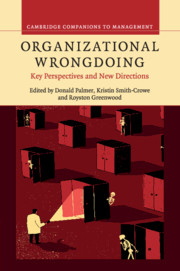Book contents
- Frontmatter
- Contents
- List of figures
- List of tables
- List of contributors
- Foreword
- 1 The imbalances and limitations of theory and research on organizational wrongdoing
- 2 On taking the theoretical substance of outcomes seriously: a meta-conversation
- 3 Wrong paths to right: defining morality with or without a clear red line
- 4 From market enablers to market participants: redefining organizational and political-legal arrangements and opportunities for financial wrongdoing,1930s–2000
- 5 Wrongdoing and market development: an examination of the distinct roles of trust and distrust
- 6 Bad apples, bad barrels and bad cellars: a “boundaries” perspective on professional misconduct
- 7 S/he blinded me with science: the sociology of scientific misconduct
- 8 Social networks and organizational wrongdoing in context
- 9 Falling stars: celebrity, infamy, and the fall from (and return to) grace
- 10 Compensation and employee misconduct: the inseparability of productive and counterproductive behavior in firms
- 11 Beware of organizational saints: how a moral self-concept may foster immoral behavior
- 12 “Is it me? Or is it me?” The role of coactivated multiple identities and identifications in promoting or discouraging workplace crimes
- 13 Consequences of organizational misconduct: too much and too little punishment
- 14 Who bears the brunt? A review and research agenda for the consequences of organizational wrongdoing for individuals
- 15 Organizational wrongdoing and media bias
- 16 Ethical learning: releasing the moral unicorn
- Index
- References
6 - Bad apples, bad barrels and bad cellars: a “boundaries” perspective on professional misconduct
Published online by Cambridge University Press: 05 July 2016
- Frontmatter
- Contents
- List of figures
- List of tables
- List of contributors
- Foreword
- 1 The imbalances and limitations of theory and research on organizational wrongdoing
- 2 On taking the theoretical substance of outcomes seriously: a meta-conversation
- 3 Wrong paths to right: defining morality with or without a clear red line
- 4 From market enablers to market participants: redefining organizational and political-legal arrangements and opportunities for financial wrongdoing,1930s–2000
- 5 Wrongdoing and market development: an examination of the distinct roles of trust and distrust
- 6 Bad apples, bad barrels and bad cellars: a “boundaries” perspective on professional misconduct
- 7 S/he blinded me with science: the sociology of scientific misconduct
- 8 Social networks and organizational wrongdoing in context
- 9 Falling stars: celebrity, infamy, and the fall from (and return to) grace
- 10 Compensation and employee misconduct: the inseparability of productive and counterproductive behavior in firms
- 11 Beware of organizational saints: how a moral self-concept may foster immoral behavior
- 12 “Is it me? Or is it me?” The role of coactivated multiple identities and identifications in promoting or discouraging workplace crimes
- 13 Consequences of organizational misconduct: too much and too little punishment
- 14 Who bears the brunt? A review and research agenda for the consequences of organizational wrongdoing for individuals
- 15 Organizational wrongdoing and media bias
- 16 Ethical learning: releasing the moral unicorn
- Index
- References
Summary
Parmalat – formerly one of the largest dairy companies in the world – went bankrupt on December 24, 2003, leaving behind a “hole” of 14 billion euros, a sum almost twice the company's 2002 sales turnover. Subsequent investigations revealed that the company's financial accounts had consistently and deliberately been falsified for each of the thirteen years that Parmalat was listed on the Milan Stock Exchange. During those years, professionals – who are supposed to act as gatekeepers (Coffee 2005, 2006) – did not (or, in some cases, decided not to) see what was going on. Deloitte – which was auditing the company's group accounts – did not raise any concerns until October 2003 when they issued a disclaimer on the company's accounts, as they could not determine the amount of a fund held by a subsidiary. Standard and Poor's constantly rated the company at the investment grade and even improved its outlook only a few months before the company defaulted. Securities analysts, similarly, remained positive on Parmalat's shares until the company was already on the verge of bankruptcy; only a few days before the fraud was detected, fifty-seven of sixty-six of their equity research reports recommended buying or holding the company's shares.
Enron's story, one of the biggest scandals in American history, is not much different, although it took place in the supposedly more developed US stock market. As in the Parmalat story, professionals did not effectively perform their ascribed roles. Arthur Andersen, the company's auditors, consistently approved Enron's accounts without raising any concerns and failed to inform “the company's audit committee about both the accounting policies in use at Enron and the unusual transactions the company had conducted” (Batson Report 2003: 40–41). Management consultancies such as McKinsey, which advised Enron, endorsed its strategic repositioning and praised its “asset light” strategy (Kipping, Kirkpatrick, and Muzio 2006). Not until four days before bankruptcy was declared on December 2, 2001, did rating agencies lower their ratings of the company to below the mark of a safe investment. As late as October in the same year, fifteen securities analysts rated Enron a “buy” and twelve of them recommended it as a “strong buy.”
- Type
- Chapter
- Information
- Organizational WrongdoingKey Perspectives and New Directions, pp. 141 - 175Publisher: Cambridge University PressPrint publication year: 2016
References
- 38
- Cited by



